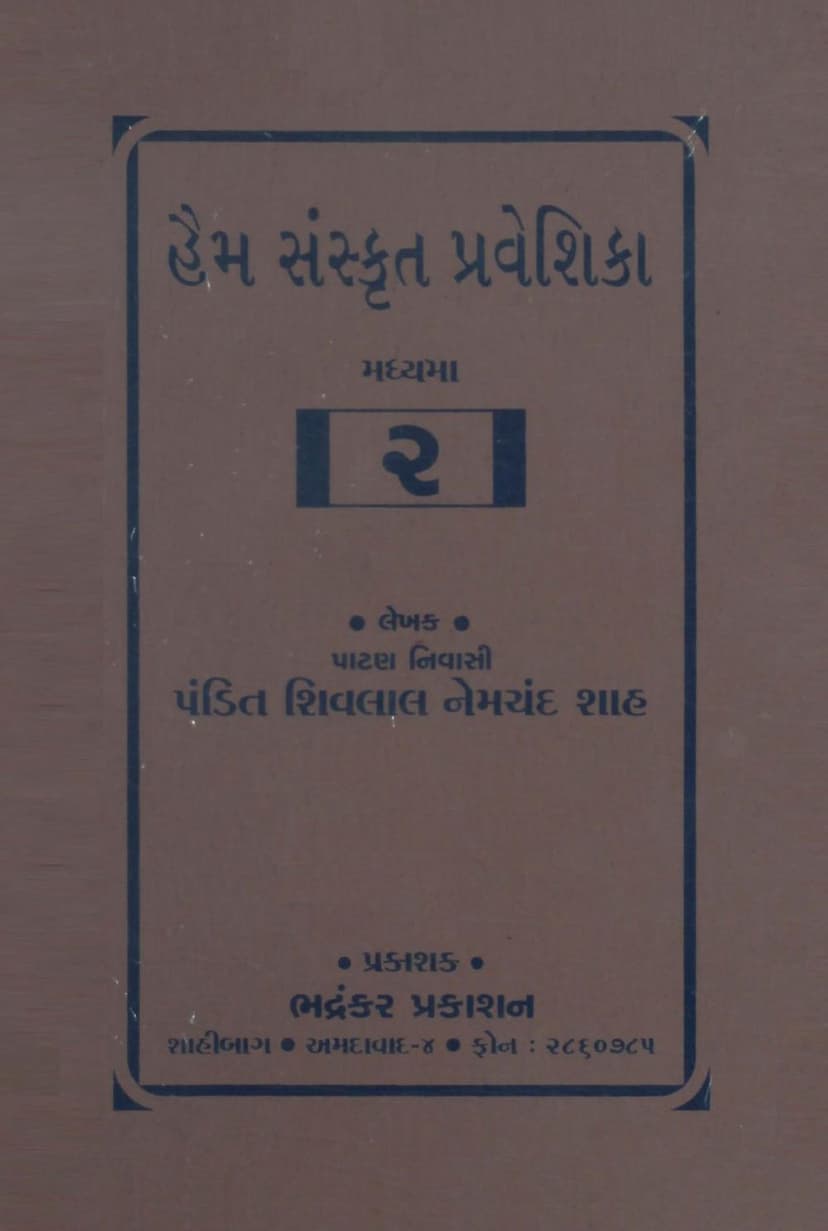Haim Sanskrit Praveshika 2
Added to library: September 1, 2025

Summary
Based on the provided text, here's a comprehensive summary of "Haim Sanskrit Praveshika 2" by Shivlal N Shah:
Book Title: Haim Sanskrit PravesAika | Madhyama (Intermediate) - Volume 2 Author: Pandit Shivlal Nemchand Shah (Resident of Patan) Publisher: Bhadrankar Prakashan, Shahibaug, Ahmedabad Catalog Link: https://jainqq.org/explore/008491/1
Overall Purpose and Philosophy:
This book is the second volume in the "Haim Sanskrit Praveshika" series, designed to introduce students to Sanskrit language learning with a specific focus on the principles of Acharya Hemachandra Suri's renowned "Siddha-Hema Vyakarana" (grammar). The series aims to make the study of Sanskrit accessible and engaging, building a foundation for students to eventually master the comprehensive "Siddha-Hema Vyakarana" and gain profound knowledge of Jain scriptures and practices. The author emphasizes that understanding Sanskrit and Prakrit is crucial for comprehending Jain philosophical tenets, rituals, and commentaries, ultimately leading to right knowledge and liberation.
Key Content and Structure:
The book follows a progressive approach to teaching Sanskrit, building upon the foundational concepts likely introduced in the first volume ("Prathama"). The "Madhyama" (Intermediate) level focuses on expanding grammatical knowledge and vocabulary. The structure includes:
- Detailed Grammatical Explanations: The book systematically covers various aspects of Sanskrit grammar, likely including:
- Verb Conjugations (Dhatu Rupa): Extensive coverage of verb forms for different tenses (Present, Past, Future, Imperative, etc.), moods (Indicative, Subjunctive, Optative, etc.), and voices (Active, Passive, Impersonal). This is detailed through various "Gana" (verb classes) and their specific modifications.
- Noun Declensions (Nama Rupa): Comprehensive explanation of noun declensions, including those ending in vowels and consonants, with extensive examples.
- Compound Words (Samasa): Detailed exploration of different types of Sanskrit compounds like Bahuvrihi, Avyayibhav, Tatpurush (including Karmadharaya and Digu), and Dwandva.
- Affixes (Pratyaya): Explanation of various affixes like Taddhita, Krita, and their role in forming new words.
- Prefixes (Upasarga): Introduction to prefixes and their influence on verb meanings and forms.
- Irregular Nouns and Verbs: Specific sections addressing exceptions and irregular forms.
- Extensive Examples and Exercises: Each grammatical concept is illustrated with numerous Sanskrit and Gujarati sentences. The book provides ample practice through these examples and likely includes exercises to reinforce learning.
- Vocabularies (Kosha): Sanskrit vocabularies are provided with each lesson and in the appendices to aid in word acquisition.
- Appendices: The book includes valuable appendices suchSanskrit Verb Roots (Dhatu Kosha), Sanskrit Word Lists (Shabda Kosha), and the rules from the eighth chapter of "Siddha-Hema Vyakarana" (which deals with Prakrit and other dialects).
- Historical and Contextual Information: The book includes a brief biography of Acharya Hemachandra Suri, highlighting his significant contributions to grammar and Jainism. It also discusses the importance of Sanskrit and Prakrit for understanding Jain scriptures and practices.
- Endorsements and Support: The book features endorsements from various respected Jain scholars and monks, indicating its value and effectiveness. It also acknowledges the support of individuals and Jain societies in its publication, emphasizing a community effort towards knowledge dissemination.
Key Themes and Focus:
- Adherence to Hemachandra's Grammar: The core methodology is based on Acharya Hemachandra Suri's "Siddha-Hema Vyakarana," which is considered authoritative in both Sanskrit and Prakrit grammar.
- Progressive Learning: The series is designed for students to gradually progress from basic to intermediate and eventually advanced levels of Sanskrit proficiency.
- Jain Religious Context: The importance of Sanskrit and Prakrit is consistently linked to the study and practice of Jainism, highlighting their role in spiritual understanding and liberation.
- Clarity and Simplicity: Despite the depth of grammatical concepts, the author strives to present the material in a clear and accessible manner, making it "student-friendly."
Significance and Contribution:
"Haim Sanskrit Praveshika 2" is presented as a vital resource for promoting the study of Hemachandra's grammar, particularly in Gujarat, where its propagation is seen as a means to enhance the region's cultural heritage. The book aims to bridge the gap between modern pedagogical methods and the study of classical Sanskrit grammar, making it a valuable tool for aspiring scholars of Sanskrit and Jain literature.